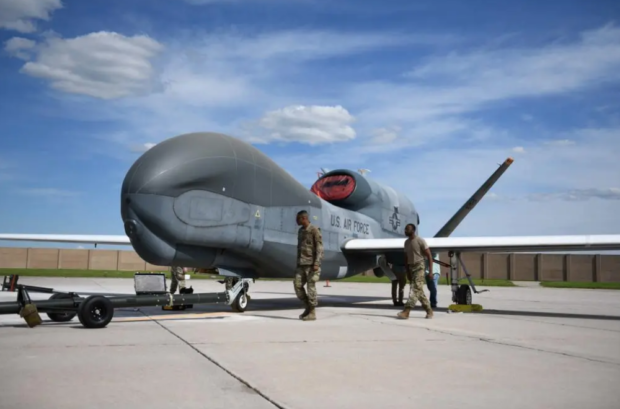A U.S. RQ-4 Global Hawk arrived at Royal Air Force Fairford, England, for a temporary deployment Thursday, as part of U.S. Air Forces in Europe – Air Forces Africa’s efforts to diversify operating locations and enhance integration with NATO Allies.
This marks the first U.S. RQ-4 deployment to England. The deployed U.S. RQ-4 will conduct operations through international and Allied airspace in accordance with international norms and standards.
The deployment also signifies the next step in USAFE-AFAFRICA’s implementation of the U.S. Air Force’s agile combat employment concept, under which aircraft may be dispersed from typical operating locations to alternate airfields to enhance survivability.
The 501st Combat Support Wing at RAF Fairford has routinely supported similar deployments, including when U.S. Air Force B-52 Stratofortress aircraft operated from RAF Fairford for Bomber Task Force 24-3 in June.
The support and execution of these missions demonstrate U.S. commitment to NATO Allies and partners and set conditions for potential future operations in the U.S. European Command area of responsibility.
The Global Hawk, call sign Forte 12, touched down at RAF Fairford shortly before 10:30 p.m. local time Aug. 22 after a nearly 24-hr. flight from Sigonella, Italy, that traversed much of Eastern Europe and Finland before flying west across Sweden and Norway and down to the UK. The Northrop Grumman-built uncrewed aircraft used newly segregated airspace to descend from its operating altitude of over 50,000 ft. to land at Fairford.
The Global Hawk is the largest UAS to land in the UK, and large crowds were gathered at the end of the runway to see the aircraft land.
According to the UK Civil Aviation Authority (CAA), the flight is the first of two planned for August to ensure that the flight operations comply with the conditions set by the regulator when it finally gave the green light for flights by U.S. high-altitude, long-endurance UAS from the airfield in February.
The UK defense ministry made requests to change the airspace to enable UAS flight operations from Fairford as far back as November 2021. Since then, the CAA has undertaken an extensive consultation exercise to enable the creation of the giant EDG218 segregated airspace complex that will allow the aircraft to ascend and descend to and from its operating altitude. The latest documentation suggests there are concerns that the airspace could affect operations at Birmingham Airport, 50 mi. to the north.
The complex has been created with a 3-hr. window to accommodate arrivals and departures but also to ensure that the airspace is active for a sufficient time to allow for emergency or contingency scenarios. Activation will be by notice to airmen at least 24 hr. prior to operations.
The airspace changes originally were developed to support NATO’s Agile Combat Employment concept to generate sustained combat air power through dispersal, but now will see UAS operate from the airfield around 2-3 times per week, and mainly during the hours of darkness to minimize the effect on commercial air traffic, the airspace changes documents state.
Skies in the area are used around the clock by aircraft descending into and climbing out of London’s airports and transiting from Europe to routes across the Atlantic as well as for flights to Southern Ireland. However, the airspace change documents say that the UK Defense Ministry sees the UAS flights as “strategically and operationally vital” to the government, helping to strengthen bilateral relationships with the U.S. and NATO.
RAF Fairford currently hosts an Expeditionary Reconnaissance Squadron flying the Lockheed U-2 and is used regularly by Air Force Global Strike Command routine Bomber Task Force deployments into the European theater, having recently hosted a detachment of Boeing B-52s in May. The airfield also accommodates the annual Royal International Air Tattoo. It is expected that the UAS presence eventually will replace the U-2s at Fairford as the type is withdrawn from U.S. Air Force use.
The U.S. Air Force already is routinely flying RQ-4s from Sigonella Naval Air Station in Italy, with many flights being flown in the Black Sea monitoring Ukraine alongside NATO-operated Global Hawks and U.S. Navy-operated MQ-4 Tritons
Sources: USAFE-AFAFRICA Public Affairs; Aviation Week

